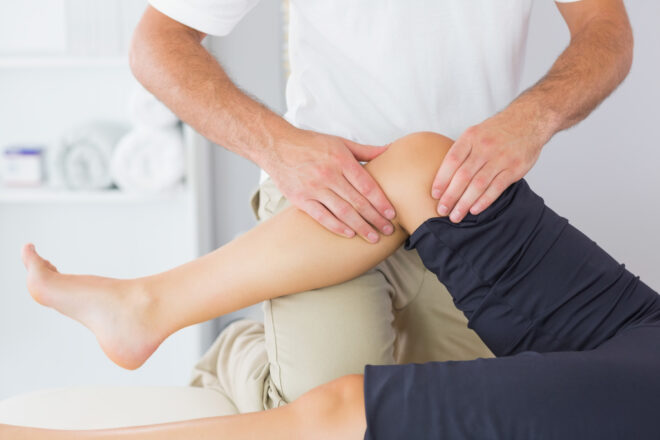Strained muscles? Muscle pain? The muscle activation technique may help.
According to the CDC, injuries related to recreational activities and sports affected 8.6 million people in 2014. But even if you’re not injured, muscle activation therapy may help relieve muscle strain.
In this post, we explain what muscle activation therapy is, see how it differs from other practices, and review its potential benefits. We’ll also look at some muscle activation exercises.
Let’s start with the basics.
In This Article:
What Is MAT?
MAT is based on the concept that muscle weakness causes muscle tightness. By addressing muscle tightness, it seeks to improve your range of motion.
A better range of motion means you can perform everyday tasks more efficiently and without pain.
MAT starts from the premise that muscle tightness is a reaction to muscle weakness due to injury, stress, or overuse.
It identifies strained or damaged muscles and strengthens related muscles to compensate.
MAT is non-invasive and complements other physical therapy techniques. You can have it alongside physical therapy, massage therapy, and personal training.
So far, so good, but how is MAT different from chiropractic or massage therapy?
MAT focuses on muscles that don’t work properly and aims to improve their function. It activates muscles that don’t work in balance. The key words here are muscle activation and muscular balance.
MAT was developed more than 20 years ago by Greg Roskopf. The Denver-based athletic consultant used the technique to help NFL legend Peyton Manning recover from four neck injuries and return to the top of his game.
Most muscle activation technique specialists tend to be physical therapists. That said, you may come across chiropractic MAT provided by chiropractors.
How Do I Reactivate My Muscles?
You can reactivate your muscles by getting them to contract and relax properly. For this, it’s crucial for your muscular-skeletal system and your brain to communicate effectively. It may sound a bit complicated, but it’s simple.
Many exercises can help activate your muscles. Start with a dynamic warmup, and then focus on the targeted muscles you want to activate.
Walking lunges can activate your quads. Monster walks can activate your glutes. Push-ups can activate your chest muscles. Band pulls can activate your shoulders.
However, while you may already be aware of certain muscle imbalances, to make the most of MAT, you need to see a MAT specialist.
They will guide you through the movements and exercises needed to maximize results.
Who Can Benefit From Muscle Activation Technique?
MAT promises benefits to everyone, from recreational runners to professional athletes. Whether you’re suffering from muscle weakness, muscle stiffness, or injury, MAT could help.
Many people find their way to MAT through injury or muscle strain. However, you don’t have to have a muscle problem or injury to benefit from muscle activation exercises.
A MAT specialist can help you identify muscle and movement restrictions you may not be aware of. After a few sessions, you may move and feel better. Your risk of injuries may also go down.
MAT works for people of all ages, from teenagers to seniors.
What to Expect From a Muscle Activation Technique Session?
During a MAT session, a specialist will use simple resistance and motion tests to check for any improper motions.
For example, they may ask you to lift your legs and notice that you can raise one leg higher than the other.
Next, the specialist will apply force using their fingers to stimulate stiff or weak muscles. They may guide you through different motions and exercises to activate your muscles and boost your range of motion.
Typically, MAT requires 1–2 sessions a week for at least several weeks. Some people see results faster than others – it’s possible to feel better immediately after the first session.
But to reap all the benefits of the technique, you want to check in for MAT for at least 6 weeks and preferably more.
Benefits of Muscle Activation Techniques
MAT brings important benefits beyond a better range of motion. It can make your muscles stronger and more balanced, reduce pain, and even boost your athletic performance.
Let’s take a closer look at the key benefits MAT can provide.
Increased strength
MAT works on improving your muscles’ ability to contract. By identifying and addressing weak points in your muscle balance, it can make your muscles stronger.
Corrects imbalances and improves coordination
When a muscle is strained or injured, other muscles try to compensate, becoming strained in their turn.
This results in muscle imbalances that can limit your range of motion and cause pain. MAT can help correct muscle imbalances.
What’s more, when your brain signals your body to move, it may tell it to use less than optimal muscle patterns to perform a movement.
You may not be aware of this, but an experienced MAT specialist can spot it. MAT can work the muscles that function in a clean path, improving coordination and speeding up movement.
Lower risk of injury by creating muscle stability
Stronger, more balanced muscles mean better muscle stability. Whether you’re running, hiking, or playing sports, MAT can create muscle stability to reduce the risk of injury.
It can target specific muscles that are prone to injury. If you’re frequently battling injuries, it can be an important step on the way to recovery.
Improved movement and flexibility
Muscle strain or narrow patterns of movement can lead to a reduced range of movement and limited flexibility.
Even if you train regularly, if you do mostly the same workouts, you may still end up with less-than-ideal movement range and flexibility.
Muscle activation therapy can address muscle inhibition to increase your range of movement.
Reduced pain from injury
Your brain signals your muscles, and your muscles, in turn, communicate with your brain. This two-way communication makes your body capable of performing countless movements.
But at the same time, it can make pain from injury worse by reinforcing specific movement patterns. Bad, persistent movement patterns you may not even be aware of can lead to a lot of pain.
Add to that muscle damage or muscle imbalances, and you can end up with a really painful injury.
Through its muscle activation and balancing, MAT helps improve how muscles contract. And with that, the communication loop between your brain and your muscles.
Increased athletic performance
You don’t have to be Peyton Manning to benefit from MAT. Muscle activation techniques can improve muscle strength and flexibility.
By balancing your muscles, they help prevent the wear and tear that invariably occurs over time when some muscles do more work than others and joints malfunction.
Better muscular symmetry means your muscles are working correctly. It can boost your overall performance. Whether you run or play sports, MAT can help make you faster and stronger.
At the same time, it can lower your risk of injury so you can keep training. Continuity is crucial to all training plans, and MAT may indirectly contribute to it.
How Can Muscle Activation Technique Be Incorporated Into a Regular Exercise Routine?
The simplest way to incorporate MAT into your training plan is to see a MAT specialist every week. They will be able to evaluate your range of motion and apply pressure on the right muscles.
Key to MAT are trainer-guided movements and other techniques you can’t do on your own. The technique is only effective when performed by a MAT specialist who knows what they are doing.
MAT addresses specific muscle problems. Genetics, training, and running style all come together to shape every runner’s body differently.
Once you see a MAT specialist, they will be able to suggest muscle release and activation exercises you can add to your training plan.
For example, if you’re wondering how to activate back muscles, you can use a wall press back. Press your back and arms against a wall and push the wall away from your body for a few seconds, then relax. Do 10 reps.
For leg muscles, you can try walking lunges, single-leg bridges, or hip hinges.
But it’s important to get tested first. MA muscle exercises that work for one runner may not be the best for another. An individualized approach to activation workouts is crucial for it to deliver optimal results.
Note: Always do a dynamic warmup first. Follow that with a muscle activation exercise, and then do your run or workout.
Takeaways
Before you try any muscle activation exercises, here are some key things to remember.
- Muscle activation techniques can benefit almost everyone, not only injured athletes.
- If you’re a runner, MAT can help improve your muscle balance and stability and reduce your risk of injury.
- MAT can help you recover from injury and reduce the risk of becoming sidelined again.
- Muscle activation contracts key muscles to strengthen them.
- You can do muscle activation exercises on your own, but you want to see a specialist for the best results.
In the end, the only way to tell how effective muscle activation is for you is to try it for yourself. You may see positive results from the very first session.














